
Gangotri Temple sits high in the Himalaya as It marks where the sacred river begins. The place has old myths about Bhagiratha and Shiva. The present temple was built by a Gorkha leader long ago. People visit as part of the Chardham journey each year.
Gangotri is a small town on a river bank as The river here is the Bhagirathi. Far above, the ice melts and the river begins. People come to say thank you to the river. They come to the white temple that stands here. The place feels calm and holy and adds to the importance of Gangotri Temple History. If you want to witness the Gangotri temple History then book the Chardham Yatra by Helicopter.
Quick facts
| Fact | Simple note |
| Place | Gangotri, Uttarkashi district, Uttarakhand. |
| River | Bhagirathi starts near Gaumukh and later becomes Ganga. |
| Temple built by | Amar Singh Thapa (Gorkha leader). |
| Height | High in the mountains (over three thousand meters). |
| Closed in winter | Idol moves to Mukhba village for six months. |
Origin of Gangotri Temple and Early History
This part of Gangotri Temple History shows how the site began. Long ago the place was just wild land and snow. People told stories about how the river came down from the ice. Over time, small shrines were made near the spring. Later, a bigger temple was built to honor the river goddess. The shrine grew as more people came to pray.
In history books you will read that a Gorkha leader helped build the main temple we see today. The site had small sacred marks before that. But the building that stands now was set up to hold regular worship and to welcome pilgrims. All this forms the early layer of Gangotri Temple History.
Mythological Stories Linked to Gangotri Temple History
The oldest story is about King Bhagiratha. Long ago, his people were in trouble. He wanted the life-giving river to come down from the sky. He prayed hard for many years. The river came, but her flow was too strong. Lord Shiva took the river in his hair to hold her. He let her out slowly so the Earth would be safe as that is why the river is called Bhagirathi and why the place is named Gangotri.
People tell this story to children. They point to the glacier and say, “This is where the river first touched the earth.” The tale makes the place feel like a gift. The temple stands where this story is said to have happened. This legend is central to Gangotri Temple History.
Who Built Gangotri Temple? Historical Accounts
Many sources say the present temple was built by Amar Singh Thapa, a Gorkha general. He lived long ago and worked in the hills of this region. He raised the shrine we see now so people could pray safely. Local records and the district pages also say this. This event is one of the turning points in Gangotri Temple History.
Later, the temple was repaired a few times. The high mountains bring snow and storms. The stone and white paint you see now came from those repairs. Local priest families take care of the rites. The same few families have done the work for many years.
Architectural Evolution in Gangotri Temple History
The temple is small and white. It looks like old hill temples. It has a main hall and small domes on top. Builders used local stone and wood. The style mixes simple mountain design with Indian temple shapes. This lets it stand in snow and wind. These features mark an important phase in Gangotri Temple History.
Over time, guards and walls were added. The floor was paved for pilgrims. Roofs were fixed in strong ways to bear snow. The temple has a neat courtyard where people gather. The look today comes from many small fixes done by the village and by visitors who cared for the place.
Role of Gangotri Temple in Chardham Yatra History
Gangotri is one of the four key shrines in the Chardham or Chota Char Dham route. Many people who want a full holy tour will visit here. The temple acts as a stop for prayer and blessing on that trip. Pilgrims come by road and by foot from nearby towns. The journey is both a test and a gift. This connection to Chardham travel is a big part of Gangotri Temple History.
People say visiting Gangotri heals the mind. The river’s pure water is part of many rituals. Families bring their elders and children. The place holds both old rites and new travelers who seek peace.
Modern Changes in Gangotri Temple History
The temple still uses old rituals. But the way people reach it has changed. Roads now go higher. Small hotels and shops have grown. Local guides help visitors stay safe. The district office gives rules for the season. These updates are now part of the modern chapter of Gangotri Temple History.
Some modern changes were forced by nature. Floods, storms, and ice breaks have hurt roads and shops in recent years. The community and government have worked on bridges and paths to keep the route open. The shrine also moves the idol to a nearby village called Mukhba for the cold months. This keeps the worship alive even when snow blocks the way. All these efforts shape the ongoing Gangotri Temple History.
Things to Know if You Plan to Go
- The shrine opens in spring and closes in autumn as plan your trip in the warm months.
- You will see the glacier and the start of the Bhagirathi river. It is a short walk from the town.
- Dress warm. Nights are cold even in summer.
- Respect the place. Keep it clean and quiet.
- Stay with local guides if you plan to trek to the glacier.
Conclusion
Gangotri Temple history is both legend and fact as the myth of Bhagiratha and Shiva gives this place its soul. The Gorkha leader who built the temple gave the site a home for prayer. Over the years, the temple’s look changed a bit but its heart stayed the same. People still come to say thanks to the river and to seek calm. If you go, bring care, warm clothes, and a quiet heart. The Gangotri Temple History lives in the river, the stones, and the stories you will carry home.


